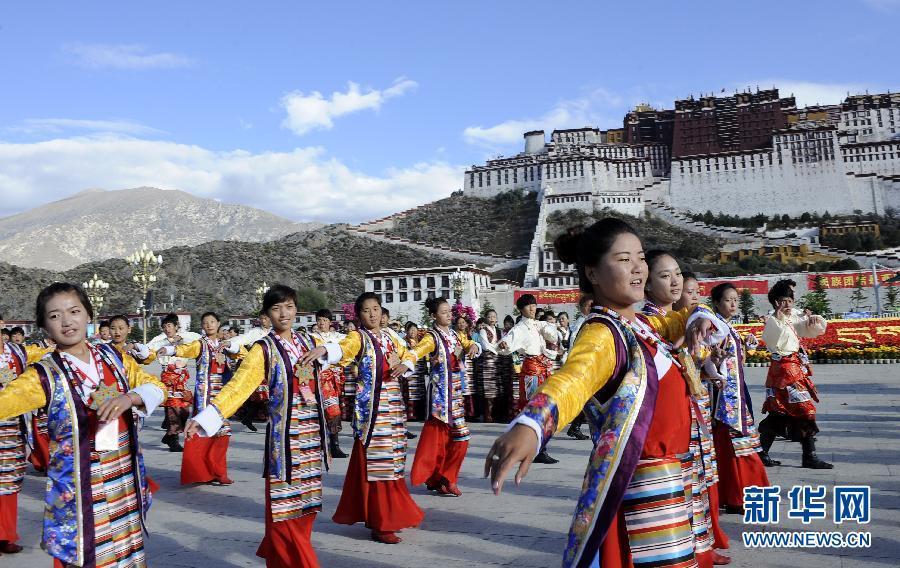By Gu Jianjun Source:CNTV 2015-08-31
Tibet Autonomous Region is one of China's five provincial-level autonomous regions carrying out the system of regional ethnic autonomy.
Under the leadership of Chinese central government, Tibet implemented the regional ethnic autonomy system in 1965 along with the establishment of Tibet Autonomous Region, which means Tibetans act as masters in the management of national and local affairs by exercising the rights of autonomy endowed by the constitution.
System of regional ethnic autonomy inherited and respected historical tradition
Tibet has been part of Chinese territory since the 13th Century. The Chinese dynastic governments of the Yuan (1279-1368), Ming (1368-1644), Qing (1644-1911) dynasties and the Republic of China (1912-1949) all kept the original social organization form and governing mechanism of Tibet, giving autonomous rights to the local Tibetan government which played an active role in maintaining national unity.
On May 23, 1951, the Chinese central government and the local Tibetan authorities signed the Agreement on Method for the Peaceful Liberation of Tibet, known as “the 17-Article Agreement”. The agreement marks a turning point in Tibetan history. The peaceful liberation of Tibet rid Tibet of aggression from imperial powers and laid the foundation for implementation of regional ethnic autonomy.

System of regional ethnic autonomy promotes Tibet's social development
Since the establishment of the Tibet Autonomous Region, the central government and the authorities of other provinces have vigorously supported Tibet, enhancing the living standards of Tibetan people and guaranteeing people's equal status and the implementation of autonomous rights.
Over the past five decades, the region has seen a rapid economic progress, social stability and unity. For example, the gross regional product of Tibet increased from 174 million yuan in 1959 to 92 billion yuan in 2014.It is expected that the growth rate of Tibet's gross product in the first half of this year will be 4.3 percent higher than the China average.
Democracy has taken a big step forward over the past 50 years. The shackles of feudal slavery were completely broken and democratic sysem has been constantly improving. Some 95 percent of villages in Tibet have elected their autonomous organizations, truly becoming masters of their fate.
Nowadays, Tibetan people are enjoying a much better life. In 2014, the per capita disposable income of farmers and herdsmen reached 7,471 yuan, and urban per capita disposable income was even higher at 22,026 yuan. Most people have cast off poverty and lead prosperous lives.
System of regional ethnic autonomy guarantees religious freedom
Under the system of regional autonomy, all ethnic groups in Tibet enjoy freedom of religious belief. There are more than 1,700 venues that can hold Tibetan Buddhist activities and 46,000 monks and nuns in Tibet. There are four mosques and 3,000 Muslim believers. There is one Catholic Church and 700 Christians. All religious activities proceed normally to meet believers' demands, and their religious freedoms are fully respected.
Tibetan Buddhism has a specific reincarnation system of Rinpoches which has also received national respect. In 1992, the Religion Bureau of the State Council () approved the successor of the 16th Karmapa Rinpoche. In 1995, Tibet finished looking for the reincarnated soul of the 10th Panchen Lama and held the enthronement ceremony for the 11th Panchen Lama according to religious rituals and historical conventions. After the peaceful liberation of Tibet, more than 30 Rinpoches have been approved by the authorities of the central government.
System of regional ethnic autonomy safeguards national unity and cements the ethnic unity
The great changes in Tibet over the last 50 years show the world that Tibetan people could not have broken away from the dark serfdom system and could not achieve leapfrog development toward modernization without national unity, peaceful liberation and regional autonomy.
However, after the 14th Dalai Lama fled abroad, he carried out a series of activities with an attempt to split the homeland, instigate turmoil and sabotage new socialist Tibet and religious harmony. For example, the Dalai Lama plotted and incited the "3.14 Riots" in Lhasaon March 24, 2008, before the 2008 Beijing Olympics was held in August.
During the construction of new Tibet, Tibetan people always stand closely with people of all ethnic groups in China, supporting regional ethnic autonomy and fighting against splitting in a bid to safeguard the stability of Tibet.
National unity is not only the supreme interest of the Chinese nation but also a lifeline for the Tibetan people. Experience from the past five decades has proved regional ethnic autonomy is a basic political system, which fits for Tibet and the development path with Chinese characteristics and Tibetan distinction is the correct choice for Tibetan people.
Copyright © Xizang Daily & China Xizang News All rights reserved
Reproduction in whole or in part without permissions prohibited
Index Code: 藏 ICP 备 05000021 号
Producer: Xizang Daily International Communication Center